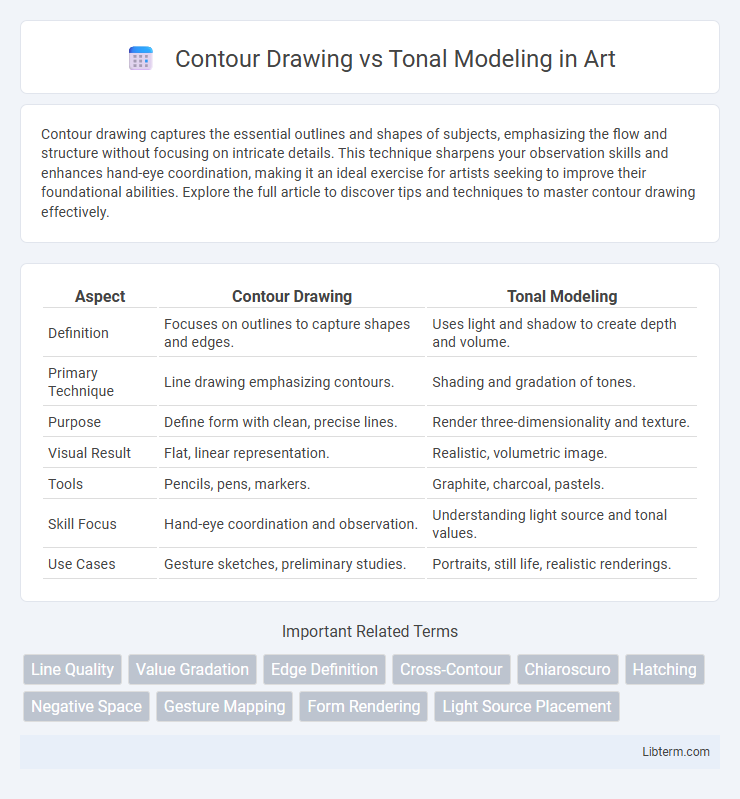Contour drawing captures the essential outlines and shapes of subjects, emphasizing the flow and structure without focusing on intricate details. This technique sharpens your observation skills and enhances hand-eye coordination, making it an ideal exercise for artists seeking to improve their foundational abilities. Explore the full article to discover tips and techniques to master contour drawing effectively.
Table of Comparison
| Aspect | Contour Drawing | Tonal Modeling |
|---|---|---|
| Definition | Focuses on outlines to capture shapes and edges. | Uses light and shadow to create depth and volume. |
| Primary Technique | Line drawing emphasizing contours. | Shading and gradation of tones. |
| Purpose | Define form with clean, precise lines. | Render three-dimensionality and texture. |
| Visual Result | Flat, linear representation. | Realistic, volumetric image. |
| Tools | Pencils, pens, markers. | Graphite, charcoal, pastels. |
| Skill Focus | Hand-eye coordination and observation. | Understanding light source and tonal values. |
| Use Cases | Gesture sketches, preliminary studies. | Portraits, still life, realistic renderings. |
Introduction to Contour Drawing and Tonal Modeling
Contour drawing emphasizes defining the edges and outlines of objects using continuous lines to capture form and proportion accurately. Tonal modeling focuses on representing light and shadow variations to create depth and volume, relying on gradients of tone rather than line work. Both techniques are foundational in art, with contour drawing establishing structure and tonal modeling enhancing three-dimensionality through value contrasts.
Defining Contour Drawing
Contour drawing emphasizes the outline and edges of objects, capturing precise shapes and proportions through continuous line work without shading. This technique trains artists to observe fine details and spatial relationships by focusing on the visible boundaries, often using a single, unbroken line. It contrasts with tonal modeling, which relies on variations in light and shadow to create depth, making contour drawing essential for developing accurate, structural representation skills.
Understanding Tonal Modeling
Tonal modeling emphasizes the gradual transition of light and shadow to create depth and volume, relying on varying shades rather than outlines. This technique captures the three-dimensional form by carefully observing light sources and how they affect surfaces. Mastery of tonal modeling enhances the realism and subtlety in artwork by focusing on tonal value relationships over line definition.
Key Differences Between the Techniques
Contour drawing emphasizes capturing the outlines and edges of a subject, prioritizing precise line work to define shapes and forms without shading. Tonal modeling focuses on rendering light and shadow to represent volume and depth, using variations in tone rather than lines to convey three-dimensionality. Contour drawing is ideal for capturing structure and details, while tonal modeling excels in creating realistic textures and gradations of light.
Artistic Goals: When to Use Each Method
Contour drawing emphasizes capturing the precise outlines and edges of subjects, making it ideal for developing hand-eye coordination and understanding form boundaries in preliminary sketches. Tonal modeling focuses on rendering light and shadow to create depth and volume, essential for achieving realistic three-dimensional effects in finished artworks. Use contour drawing during initial stages to map shapes accurately, and apply tonal modeling when refining details to convey texture and spatial relationships.
Essential Tools and Materials
Essential tools for contour drawing include fine-tipped pencils or pens and smooth drawing paper to capture precise outlines and intricate details effectively. Tonal modeling requires a broader range of materials such as graphite pencils of varying hardness, charcoal sticks, blending stumps, and textured paper to achieve depth and shading through light and shadow. Both techniques benefit from high-quality erasers, but tonal modeling demands more versatile tools to manipulate values and create realistic volume.
Step-by-Step Process: Contour Drawing
Contour drawing involves capturing the outlines and essential details of a subject through a continuous, deliberate line, emphasizing shape and proportion. The step-by-step process begins with observing the subject closely, then moving the pencil slowly and steadily along the edges without lifting it, ensuring accurate representation of contours. This technique enhances hand-eye coordination and spatial awareness, forming the foundation for more complex tonal modeling techniques.
Step-by-Step Process: Tonal Modeling
Tonal modeling involves a systematic step-by-step process that begins with establishing the basic shapes using light shading to define the object's form. Gradual layering of midtones and shadows builds depth and volume, emphasizing the transition between light and dark areas to create realism. The final steps refine highlights and subtle gradients to enhance the three-dimensional illusion through controlled tonal variations.
Common Challenges and Solutions
Contour drawing often faces challenges like maintaining accurate proportions and capturing intricate details without shading, while tonal modeling struggles with rendering smooth gradients and realistic light effects. Both techniques demand a keen observational skill to interpret forms correctly, with solutions including practice with gesture sketches for contour accuracy and mastering value scales for tonal transitions. Combining contour lines with tonal shading can bridge gaps, enhancing depth perception and overall realism in artwork.
Choosing the Right Approach for Your Artwork
Choosing between contour drawing and tonal modeling depends on the artwork's intention and focus. Contour drawing emphasizes precise outlines and edge details, making it ideal for capturing shape, structure, and gesture in line-based art. Tonal modeling uses light and shadow to create depth and volume, enhancing realism and three-dimensionality in paintings and sketches.
Contour Drawing Infographic

 libterm.com
libterm.com